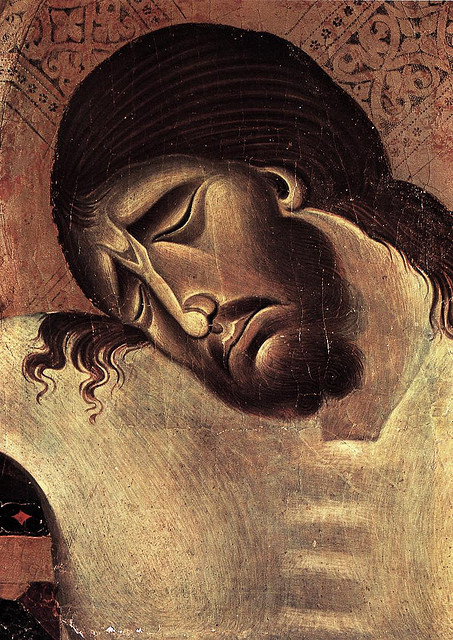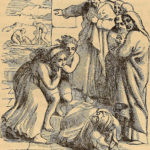We run our website the way we wished the whole internet worked: we provide high quality original content with no ads. We are funded solely by your direct support. Please consider supporting this project.

One Word
While I’ve lately been pretty distracted finishing up Benefit of the Doubt (Baker, 2013), my goal is to sprinkle in posts that comment on the distinctive commitments of ReKnew a couple of times a week. I’m presently sharing some thoughts on the second conviction of ReKnew, which is that Jesus Christ is the full and final revelation of God. Jesus is thus not to be placed alongside of other portraits of God in Scripture, which is what Christians have tended to do throughout history. Rather, everything in Scripture should be read through the lens of Christ and, more specifically, through the lens of the cross, for as I’ve argued, everything Jesus is about is summed up, and woven together, around the cross.
John 1:1 teaches us that Jesus is “the Word” who was “in beginning with God” and who is himself “God.” While scholars nuance it differently, all agree that the concept of the “Word” (logos), as John uses it, refers to God’s self-communication. As John Robinson put it, Jesus is “the face of God.” And notice the definite article. Jesus is the Word. God doesn’t having many Words. He has one, and it’s Jesus Christ. Whenever God speaks or presents himself to us, John is saying, he looks like Jesus.
So far as I can see, this means it is illegitimate to ever think we can supplement or qualify what we learn about God in Jesus Christ with other words in Scripture. Scripture’s words are only the Word of God insofar as they agree with, and in fact point to, the revelation of God in Christ. In fact, Jesus himself reflects this conviction when he chastises the religious leaders of his day saying they study Scripture while failing to see that it all “testifies about me” (Jn 5:39). So too, the resurrected Jesus chided two of his disciples for being “slow to believe all that the prophets have spoken” about him. “Did not the Messiah have to suffer these things and then enter his glory?” he asked. (Lk 24:25-26). And then, Luke says,” beginning with Moses and all the Prophets, he explained to them what was said in all the Scriptures concerning himself” (Lk 24:27).
It is apparent that Jesus is the Word of the words of Scripture. God “breathed” (2 Tim. 3:16) all Scripture for the ultimate purpose of “breathing” his Word, Jesus. In this light, the last thing we should ever do is try to supplement, let alone qualify, the revelation of God in Christ with other words.
Category: General
Tags: Bible, Cruciform Theology, Jesus, ReKnew
Related Reading

Podcast: Does God Strike Jesus Down?
Greg looks at how Matthew uses the Old Testament—specifically, Matthew 26:31. http://traffic.libsyn.com/askgregboyd/Episode_0258.mp3

Is Jesus Unique?
The Search for a Non-Unique Jesus Built into the naturalistic assumption that drives the liberal New Testament search for the “man behind the myth” is the notion that, whoever Jesus was, he cannot have been utterly unique. The laws that operate in the world today, including the laws of human behavior, have always operated. And…

The Kingdom of God (Part 2)
The Church is called to be nothing less than “the body of Christ,” a sort of corporate extension of Jesus’ incarnate body. We are called to replicate who Jesus was by manifesting who Jesus is. And this is how we expand the dome in which God is king—the Kingdom of God. By definition, therefore, the…

Was the Early Church Pacifistic? A Response to Paul Copan (#11)
In Crucifixion of the Warrior God (CWG) I argue that Jesus and Paul instruct Christians to love and bless their enemies and to unconditionally refrain from violence (e.g. Matt 5:39-45; Rom 12:14-21). Moreover, I argue that this was the prevailing attitude of Christians prior to the fourth century when the Church aligned itself with the…

Who Killed Ananias and Sapphira? A Response to Paul Copan (#6)
In his critique of Crucifixion of the Warrior God (CWG), Paul Copan makes a concerted effort to argue that the God revealed in Jesus Christ and witnessed to throughout the NT is not altogether non-violent. One of the passages Copan cites against me is the famous account of Ananias and Sapphira falling down dead immediately…

Forgiveness in the Christus Victor View of the Atonement
Did Jesus need to die on the cross to satisfy God’s wrath in order for us to be forgiven? Greg discusses the role of forgiveness in the Christus Victor view of the Atonement.
